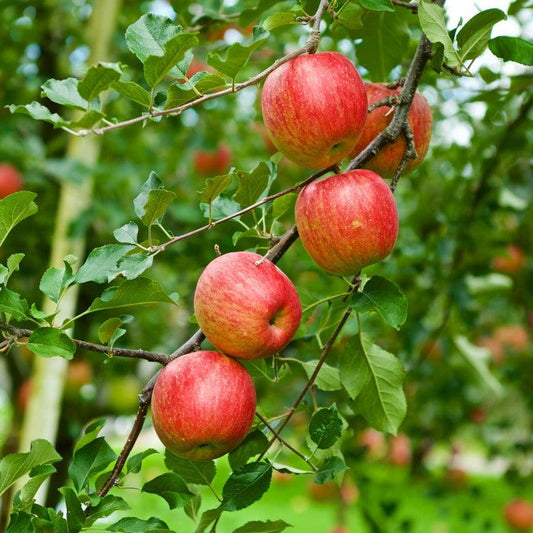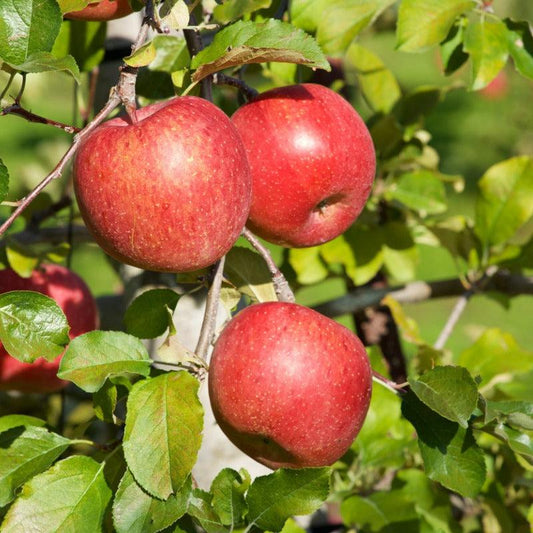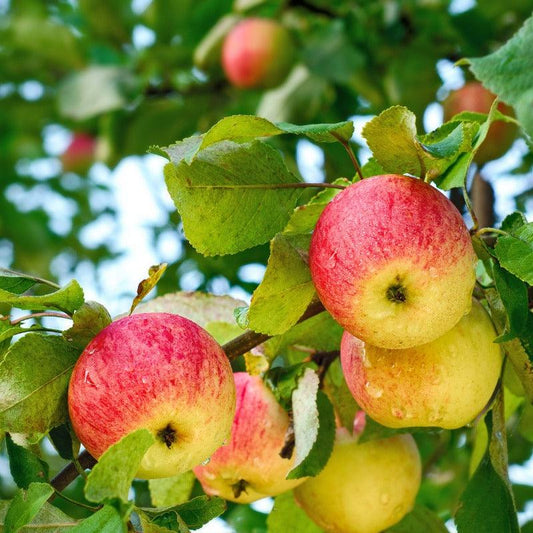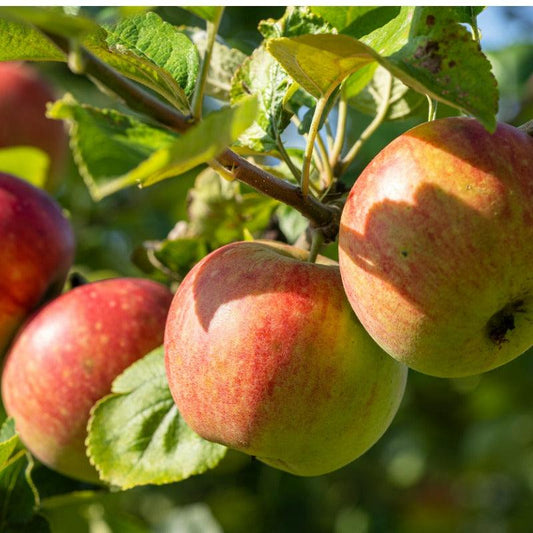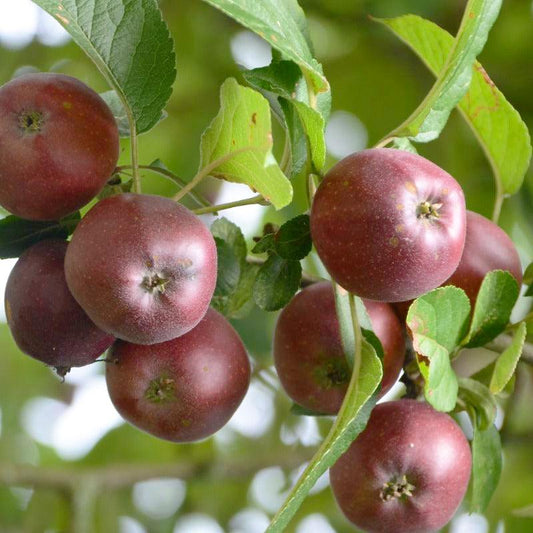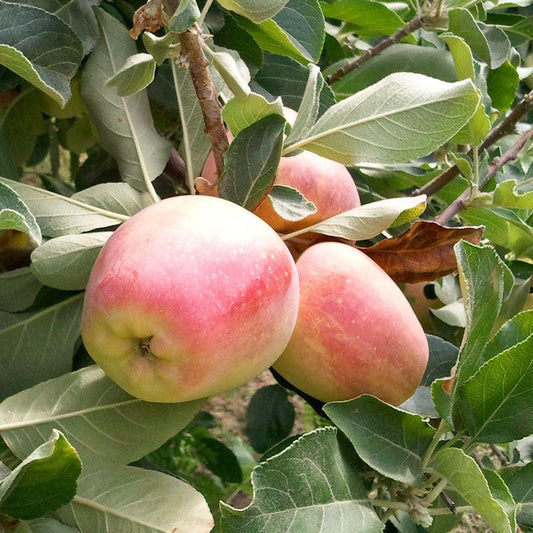The Ultimate Guide to Apple Tree Sizes and Apple Tree Rootstock Selection
Selecting the right apple tree rootstock is one of the most important decisions when planning your orchard or home garden. Rootstocks determine the apple tree sizes, growth habits, productivity, and long-term health of your trees. Whether you’re looking for a compact tree for a small yard or a larger tree for abundant harvests, understanding rootstock options helps you choose wisely for your space and climate.
To learn more about choosing varieties suited to your region and goals, see our detailed guide on choosing the right apple tree for your garden.

Understanding Apple Tree Rootstocks
For more information about different types of rootstocks and how they influence tree size and growth, see our Tree Rootstock Characteristics Chart.
Apple tree rootstocks are the root systems onto which fruiting varieties are grafted. The root system influences the size of an apple tree, disease resistance, and how soon it will start bearing fruit. A strong, well-matched rootstock ensures healthy growth and resilience in drained soils, supporting successful apple trees growing in your garden.
Standard, semi-dwarf, and dwarf rootstocks each affect how your fruit tree will grow and how much space it needs. A standard rootstock produces full-sized trees, while semi-dwarf and dwarf rootstocks are popular for home gardens and limited space areas.
Common Apple Tree Rootstocks and Sizes
Standard Rootstocks
Standard apple tree size trees can reach 25 to 30 feet tall. They are ideal for gardeners who want long-term trees that live for decades and form a natural central leader shape. These full-sized trees are slower to start bearing but yield heavy crops once mature. Proper apple tree spacing—at least 20 to 30 feet—is essential.
Semi-Dwarf Rootstocks
Semi-dwarf trees are a favorite among backyard growers who want moderate height and early fruiting. They typically reach 12 to 18 feet and thrive in drained soils with minimal staking.
Explore our selection of semi-dwarf apple trees, including varieties such as Gala Semi-Dwarf Apple Tree, Liberty Semi-Dwarf Apple Tree, and Arkansas Black Spur Semi-Dwarf Apple Tree.
Dwarf Rootstocks
If you’re short on space, dwarf apple tree size options provide big harvests in smaller areas. These trees grow 8 to 12 feet tall and often start bearing fruit in two to four years. Dwarf trees are perfect for container growing or tight apple tree spacing in small gardens.
Browse our full collection of dwarf apple trees, including favorites like Fuji Dwarf Apple Tree, Gala Dwarf Apple Tree, Honeycrisp Dwarf Apple Tree, and the Multi-Grafted Low Chill Apple Tree for regions with mild winters.

Spotlight on M7 and M111 Rootstocks
M7 Rootstock Characteristics
The M7 apple rootstock produces a tree about 60% the height of a standard tree. It supports a mature tree of medium vigor and is well-suited for home gardens. Known for its adaptability and moderate resistance to diseases, M7 thrives in drained soils and offers a balance between size and productivity. Gardeners appreciate that trees on M7 start bearing early and are easy to maintain.
When comparing M7 vs M111 rootstock, the main difference lies in M7 rootstock size (smaller and more compact) versus the larger, deeper-rooted M111, which handles drought conditions better.
M111 Rootstock Overview
M111 rootstock supports larger trees—around 80% of a standard apple tree size. It is a great choice for growers wanting sturdier trees with deep root systems that resist drought and wind. Trees on M111 often have a central leader structure and are long-lived, making them excellent for orchards and long-term fruit production.
Choosing the Right Rootstock for Your Home Garden
Your ideal rootstock depends on available space, soil type, and desired apple tree varieties. If you have limited space, go with a compact tree on dwarf or M7 rootstock. For larger trees that need less frequent watering, M111 or standard rootstocks are best.
All of our bare root apple trees are carefully selected for vigor and health. Popular options include Pink Lady Apple Tree and Granny Smith Semi-Dwarf Apple Tree.
To maintain healthy growth, monitor your trees for pests and diseases. For pest management, learn how to control aphid populations and watch our helpful video on getting rid of aphids. You can also explore our natural aphid control products.
When it comes to disease prevention, review our guides on fire blight prediction models and pear blight disease control for best orchard health practices.
Conclusion
Understanding apple tree rootstocks and tree sizes helps ensure your orchard thrives for years to come. Choose the right balance of vigor, soil adaptability, and space efficiency for the best results. Whether you plant bare root apple trees this season or add a compact tree to your patio, you’ll enjoy producing fruit for decades with the right foundation beneath your trees.
FAQs About Apple Tree Sizes and Rootstocks
What is the size of an apple tree on dwarf rootstock?
How far apart should apple trees be planted?
How soon will my apple tree start bearing fruit?
Which rootstock is best for beginners?


